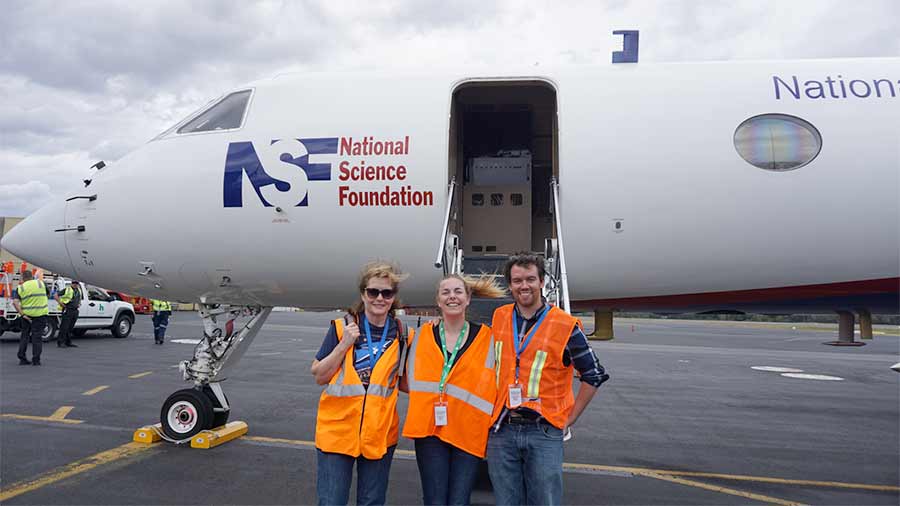
By:
- Robert Monroe
Published Date
By:
- Robert Monroe
Share This:
Scripps Joins Mission to Understand a Major Southern Ocean Climate Influencer
The world's most pristine clouds happen to be in the place with the world's roughest weather
Climate scientists at Scripps Institution of Oceanography at the University of California San Diego are joining colleagues at other institutions in the United States and Australia to get an unprecedented look at a region with the most tempestuous weather on Earth.

From left, Scripps Oceanography researchers and SOCRATES members Cynthia Twohy, Savannah Lewis, and Kevin Sanchez at the research aircraft providing in-flight data for the SOCRATES field campaign
The Southern Ocean that rings Antarctica is the regular site of giant storms well known to ship captains and pilots who traverse the region. Its remoteness and inhospitable nature mean that few comprehensive observations of its clouds and atmospheric conditions exist. That same remoteness, however, also means that Southern Ocean clouds are especially pristine. Researchers call the region a natural laboratory for the study of cloud behavior free from anthropogenic taint. Better understanding of these clouds could help scientists more accurately portray them in climate models and improve weather forecasts.
Researchers from Scripps, Colorado State University, Oklahoma University, and the University of Washington are joining scientists from Australia’s Bureau of Meteorology, the Australian Antarctic Division, Monash University, and other research centers to conduct data-gathering flights through these clouds. U.S. operations of the six-week Southern Ocean Clouds, Radiation, Aerosol Transport Experimental Study (SOCRATES), funded by the National Science Foundation (NSF), will continue through March 2018.
“SOCRATES brings a new generation of measurement technology to one of the most important and least understood regimes of clouds on Earth,” said Scripps climate scientist Lynn Russell, one of the principal investigators of SOCRATES. “The unique combination of very clean marine air, air-sea interactions, and microphysical processes that affect the Southern Ocean are likely to yield significant advances in climate models.”
Russell’s student Savannah Lewis, Scripps postdoctoral researcher Kevin Sanchez, and Scripps scientists Greg Roberts and Cynthia Twohy are assisting flights at their origin point in Hobart, Australia. Aircraft crews deploy instrument-filled dropsondes—small, canister-like expendable packages—over the ocean while remotely profiling clouds with radar and lidar (light detection and ranging) instruments.
“The Southern Ocean is a natural laboratory for looking at cloud processes as they occur naturally, in the absence of human influences,” said Eric DeWeaver, an NSF program director of The Division of Atmospheric and Geospace Sciences. “It’s also a place where clouds don’t behave quite the way we expect them to. They’re mostly made of liquid water despite temperatures that are below freezing.”
Scripps researchers are collecting and characterizing the kinds of aerosols—small airborne particles—that create clouds and the ice crystals within them.
"The Southern Ocean clouds we've been sampling are surprisingly variable in structure, water content, and droplet concentration,” said Twohy. “Aerosol properties are also variable, although many of the particles are small and volatile, suggesting other sources of cloud condensation nuclei besides sea spray."
Researchers said the clouds that form over the Southern Ocean may have a global influence. They are a large contributor to the cooling effect that clouds provide the planet by reflecting solar radiation back to space. They may also have an effect on tropical rainfall and control the location and strength of the Southern Hemisphere jet stream.
Share This:
You May Also Like
Stay in the Know
Keep up with all the latest from UC San Diego. Subscribe to the newsletter today.


